Python SDK
Track your AI agents with full observability - traces, sub-agents, tools, memory operations, and more.
Installation
pip install voltagent
Setup
Initialize the SDK with your credentials:
import asyncio
from voltagent import VoltAgentSDK
async def main():
sdk = VoltAgentSDK(
base_url="https://api.voltagent.dev",
public_key="your-public-key",
secret_key="your-secret-key",
auto_flush=True, # Auto-send events
flush_interval=3, # Send every 3 seconds
timeout=30,
)
if __name__ == "__main__":
asyncio.run(main())
Before using the SDK, you need to create an account at https://console.voltagent.dev/ and set up an organization and project to get your API keys.
Two Usage Approaches
The Python SDK supports two approaches for resource management:
- Context Manager (Recommended)
- Manual Management
Automatic resource management with async context managers:
# Automatic resource management with async context managers
async with sdk.trace(
agentId="my-agent",
input={"query": "example"}
) as trace:
# trace is automatically ended when exiting the context
pass
Benefits:
- Automatic cleanup and error handling
- Pythonic and clean code
- Exception safety
- Recommended for most use cases
Manual resource management for more control:
# Manual resource management for more control
trace = await sdk.create_trace(
agentId="my-agent",
input={"query": "example"}
)
try:
# Your logic here
pass
finally:
await trace.end(status=TraceStatus.COMPLETED)
Benefits:
- Fine-grained control over resource lifecycle
- Better for long-running processes
- Explicit error handling
- Useful when you need custom cleanup logic
Step-by-Step Guide
Create a Trace
A trace represents one complete agent execution session. Every agent operation must happen within a trace.
- Context Manager
- Manual
async with sdk.trace(
agentId="support-agent-v1",
input={"query": "How to reset password?"},
userId="user-123",
conversationId="conv-456",
tags=["support", "password-reset"],
metadata={
"priority": "high",
"source": "web-chat",
},
) as trace:
print(f"Trace created: {trace.id}")
# Trace automatically ends when exiting context
from voltagent import TraceStatus
trace = await sdk.create_trace(
agentId="support-agent-v1",
input={"query": "How to reset password?"},
userId="user-123",
conversationId="conv-456",
tags=["support", "password-reset"],
metadata={
"priority": "high",
"source": "web-chat",
},
)
try:
print(f"Trace created: {trace.id}")
# Your agent logic here
finally:
await trace.end(
status=TraceStatus.COMPLETED,
output={"result": "Query resolved successfully"},
)

Add an Agent to the Trace
Now let's add the main agent that will handle the user's request:
agent = await trace.add_agent({
"name": "Support Agent",
"input": {"query": "User needs password reset help"},
"instructions": "You are a customer support agent specialized in helping users with account issues and password resets.",
"metadata": {
"modelParameters": {
"model": "gpt-4",
},
},
})
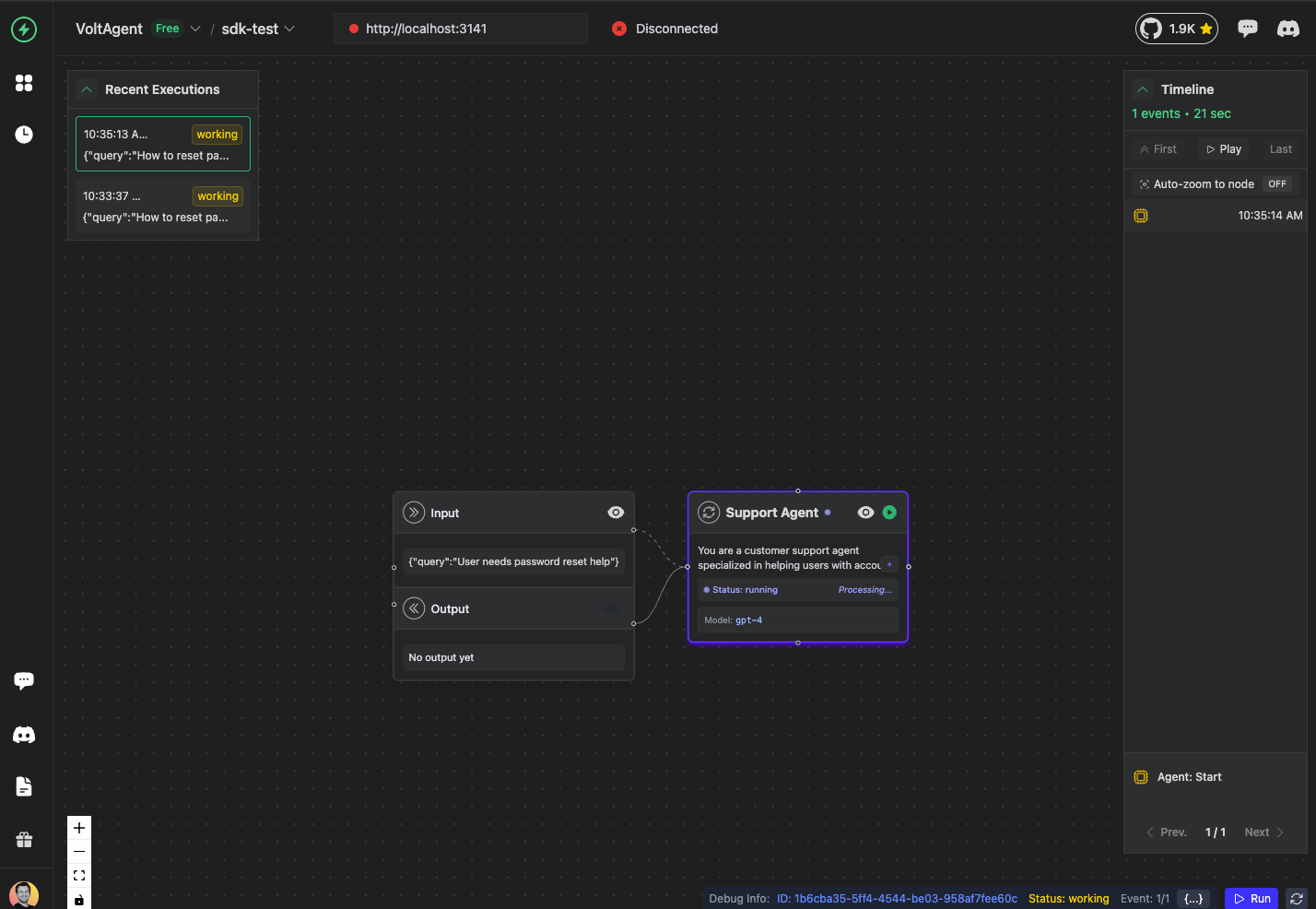
Understanding Agent Metadata
Agent metadata helps you organize and filter your observability data. Here's what each field means:
modelParameters: Built-in SDK field for model configuration (model name, temperature, etc.)- Custom fields: Add any domain-specific metadata for your use case (user-defined)
metadata = {
# Built-in SDK field
"modelParameters": {
"model": "gpt-4",
"temperature": 0.7,
"max_tokens": 1000,
},
# Your own custom metadata (examples)
"user_session": "session_abc123",
"priority": "high",
"department": "customer-success",
"region": "us-east-1",
}
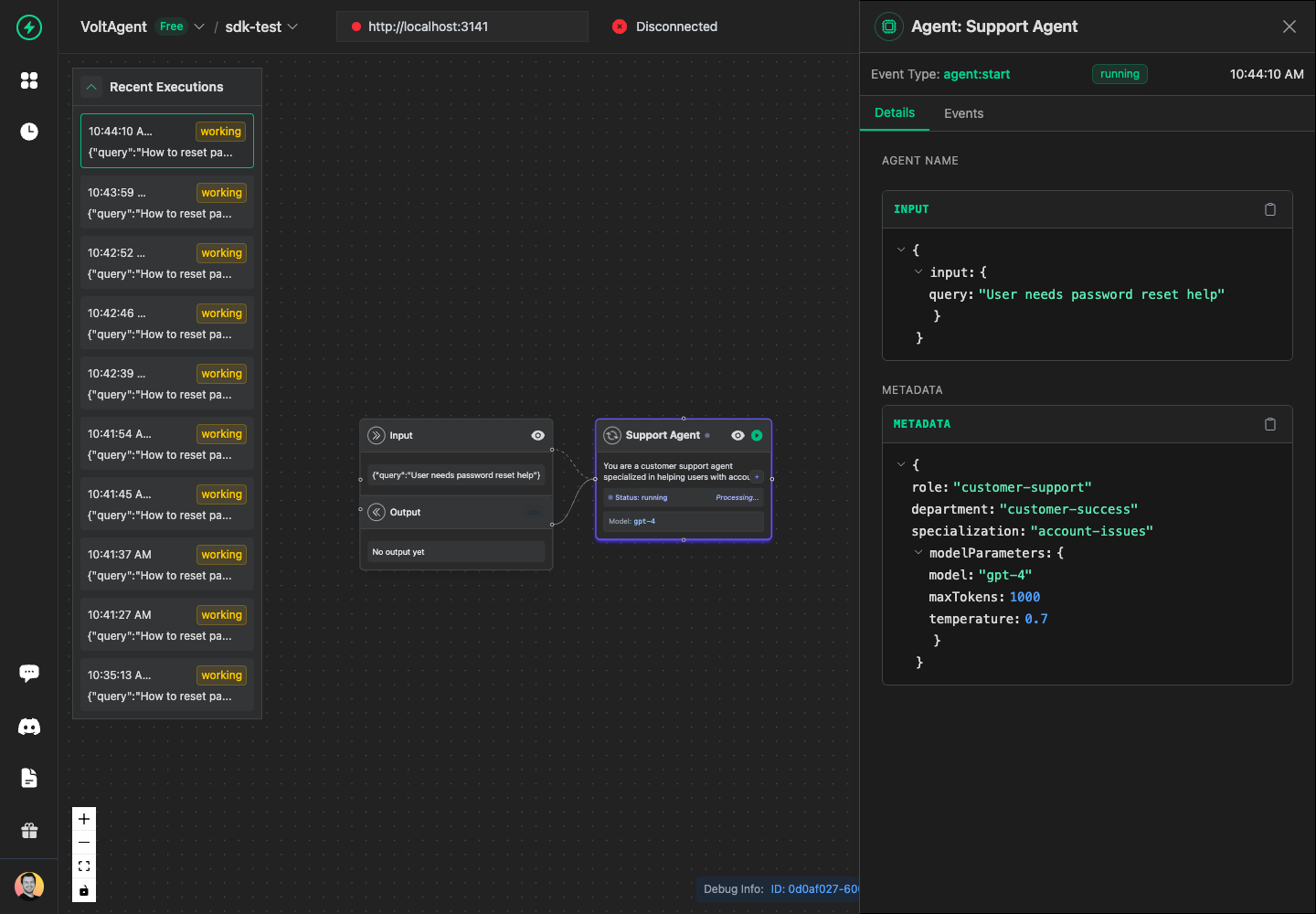
💡 Trace Completion
- Context Manager (Automatic)
- Manual (Explicit)
async with sdk.trace(agentId="agent") as trace:
# Trace automatically ends with SUCCESS when exiting normally
# Automatically ends with ERROR if exception occurs
pass# Success
await trace.end(
status=TraceStatus.COMPLETED,
output={"result": "Query resolved successfully"},
usage=TokenUsage(prompt_tokens=150, completion_tokens=85, total_tokens=235),
)
# Error
await trace.end(
status=TraceStatus.ERROR,
output={"error": "Failed to process query"},
metadata={"errorCode": "TIMEOUT"},
)
Add a Tool to the Agent
Tools represent external services or APIs that your agent uses. Let's add a knowledge base search tool:
search_tool = await agent.add_tool({
"name": "knowledge-base-search",
"input": {
"query": "password reset procedure",
"max_results": 5,
},
"metadata": {
# Add your own custom metadata
"search_type": "semantic",
"database": "support-kb",
"version": "v2",
},
})
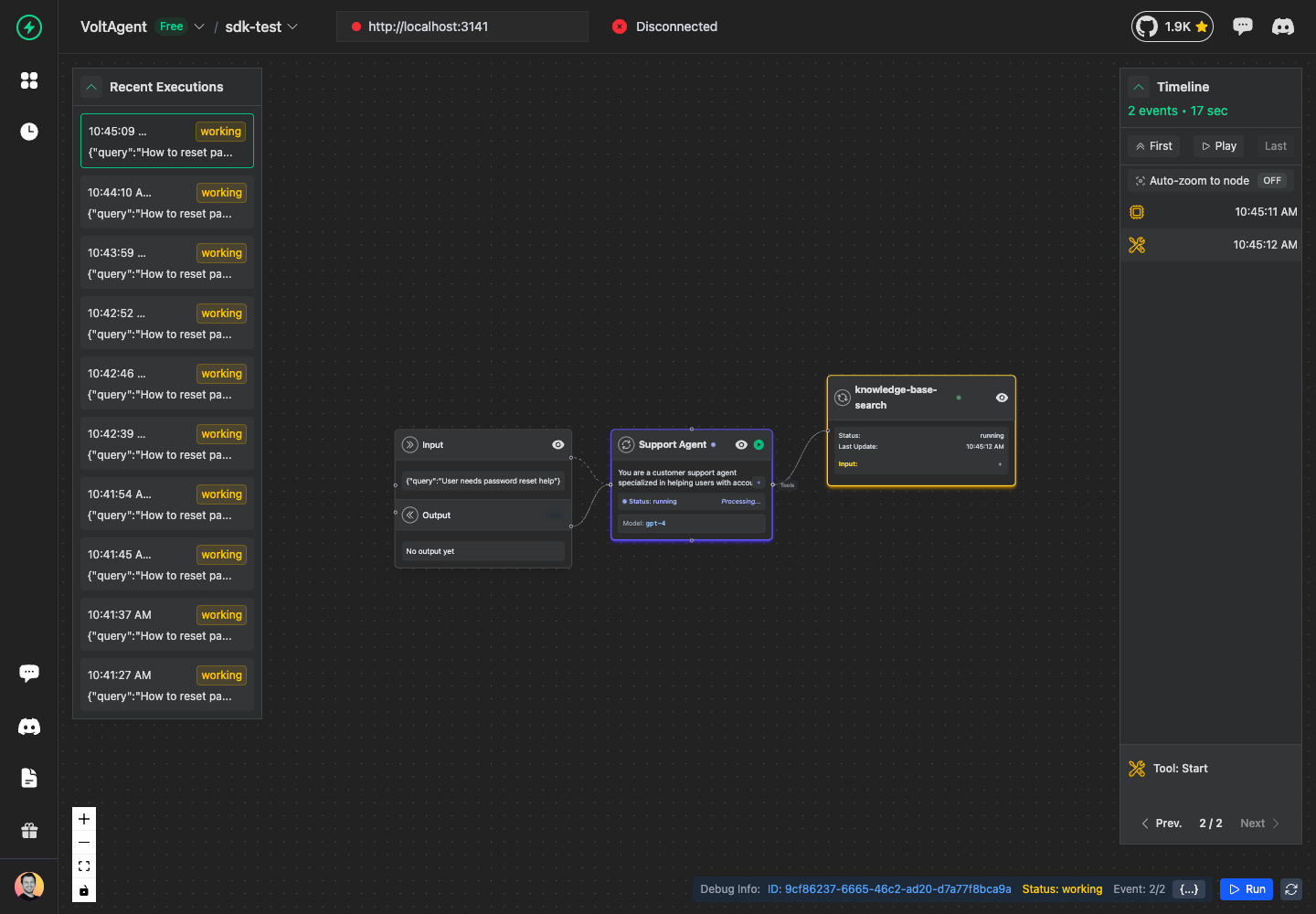
Tool Success
When the tool executes successfully:
await search_tool.success(
output={
"results": ["Reset via email", "Reset via SMS", "Contact support"],
"count": 3,
"relevance_score": 0.89,
},
metadata={
"search_time": "0.2s",
"index_used": "support-kb-v2",
},
)
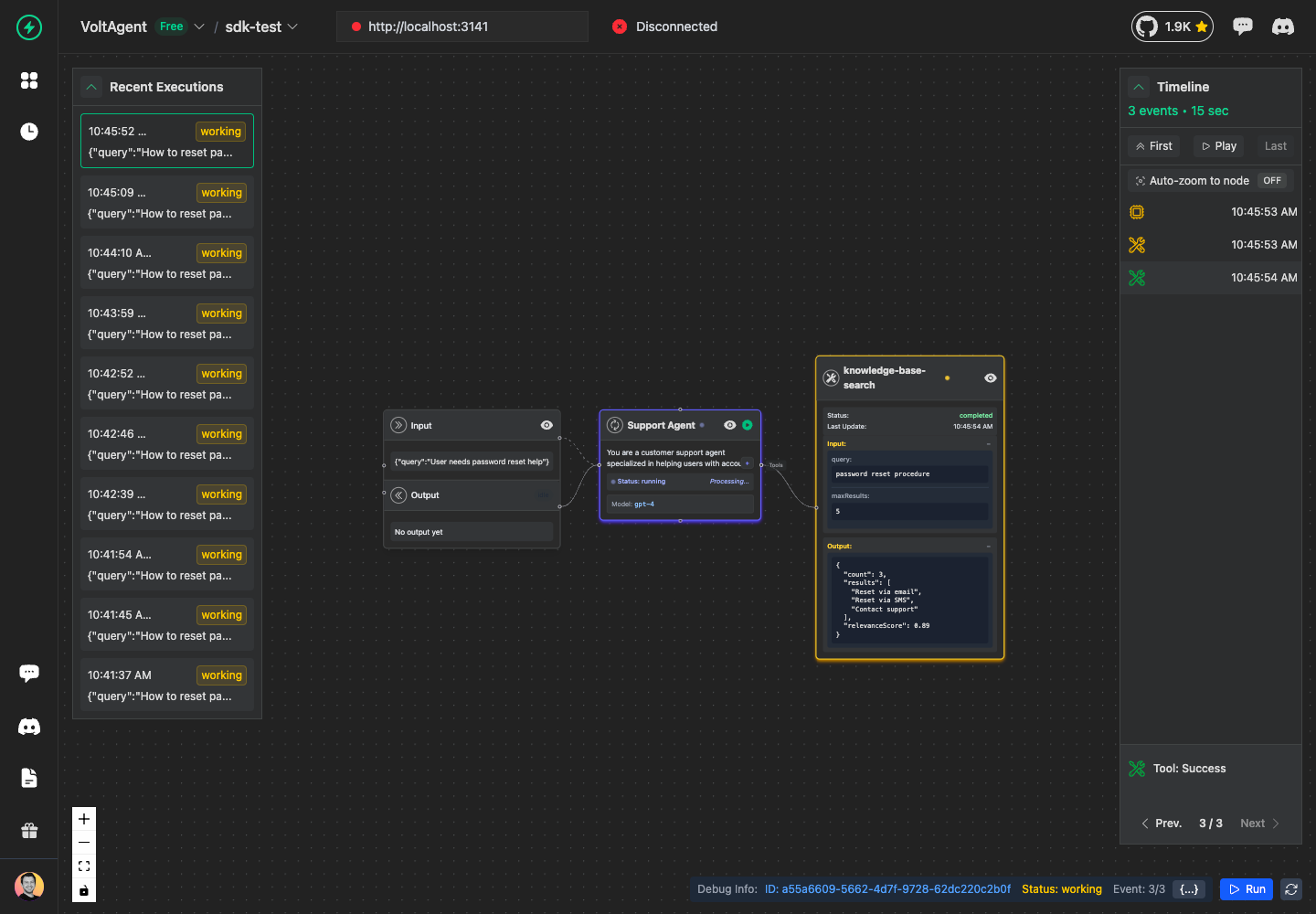
Tool Error
When the tool fails, you can report errors in two ways:
- Using Exception
- Using Structured Error
await search_tool.error(
status_message=Exception("Database connection timeout"),
metadata={
"database": "support-kb",
"timeout_ms": 5000,
},
)
await search_tool.error(
status_message={
"message": "Database connection timeout",
"code": "DB_TIMEOUT",
"details": {"timeout_ms": 5000},
},
metadata={
"database": "support-kb",
"timeout_ms": 5000,
},
)
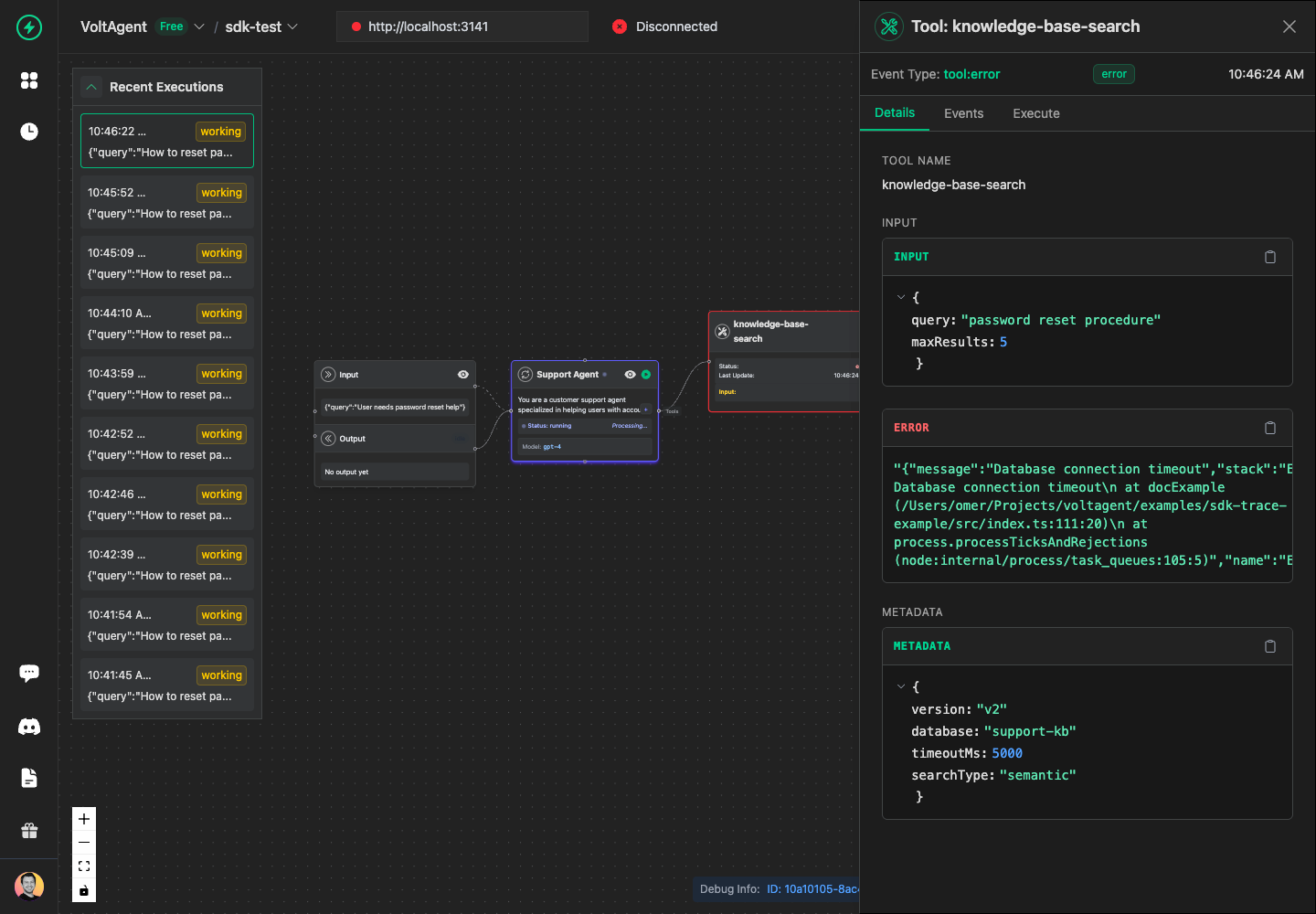
Add Memory Operations
Memory operations track data storage and retrieval. They work exactly like tools with success and error states:
memory_op = await agent.add_memory({
"name": "user-context-storage",
"input": {
"key": "user_123_context",
"value": {
"last_login": "2024-01-15",
"account_type": "premium",
"preferences": {"language": "en"},
},
"ttl": 3600, # 1 hour
},
"metadata": {
"type": "redis",
"region": "us-east-1",
},
})
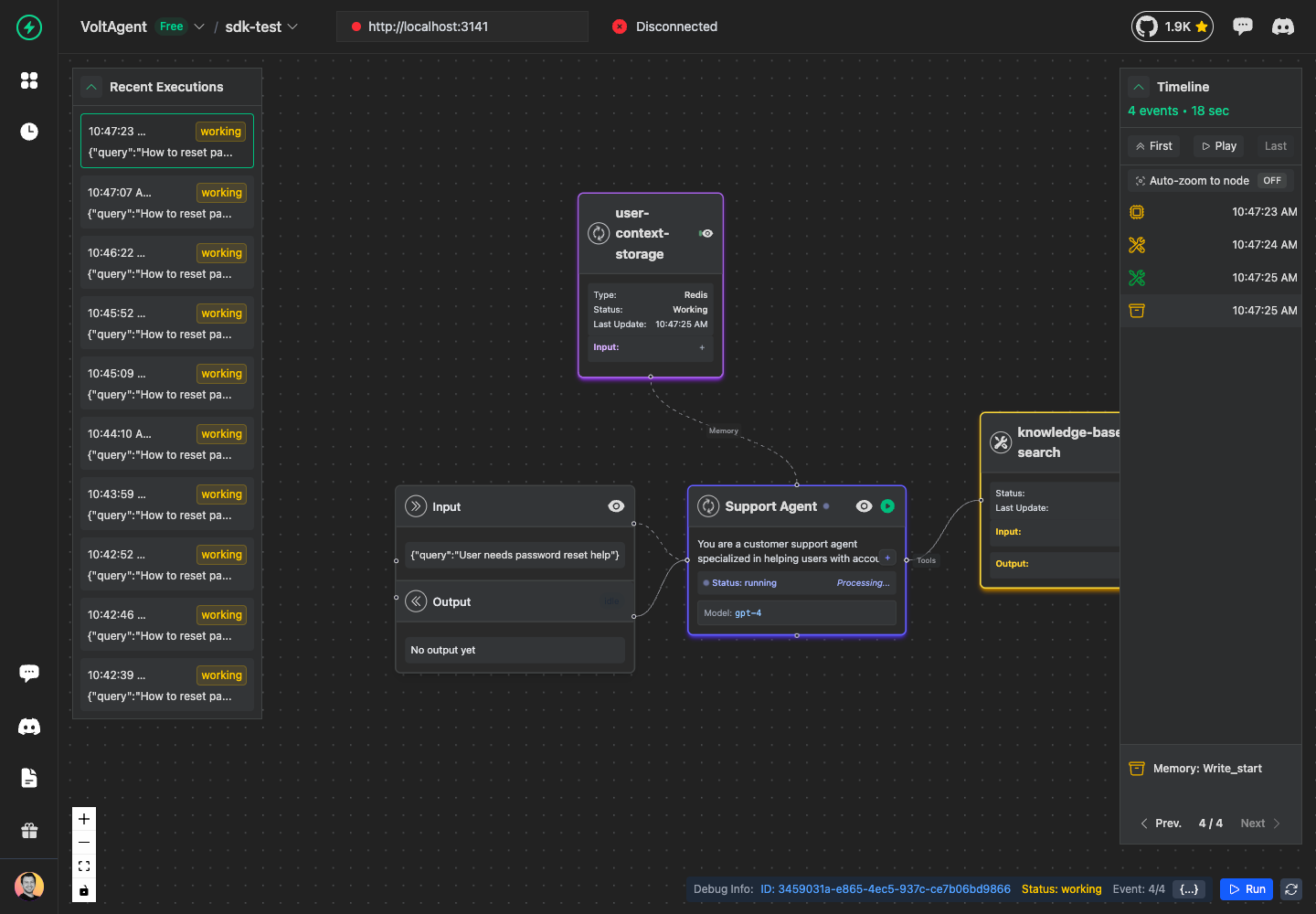
Memory Success
await memory_op.success(
output={
"stored": True,
"key": "user_123_context",
"expires_at": "2024-01-15T15:00:00Z",
},
metadata={
"cache_hit": False,
"storage_latency": "2ms",
},
)
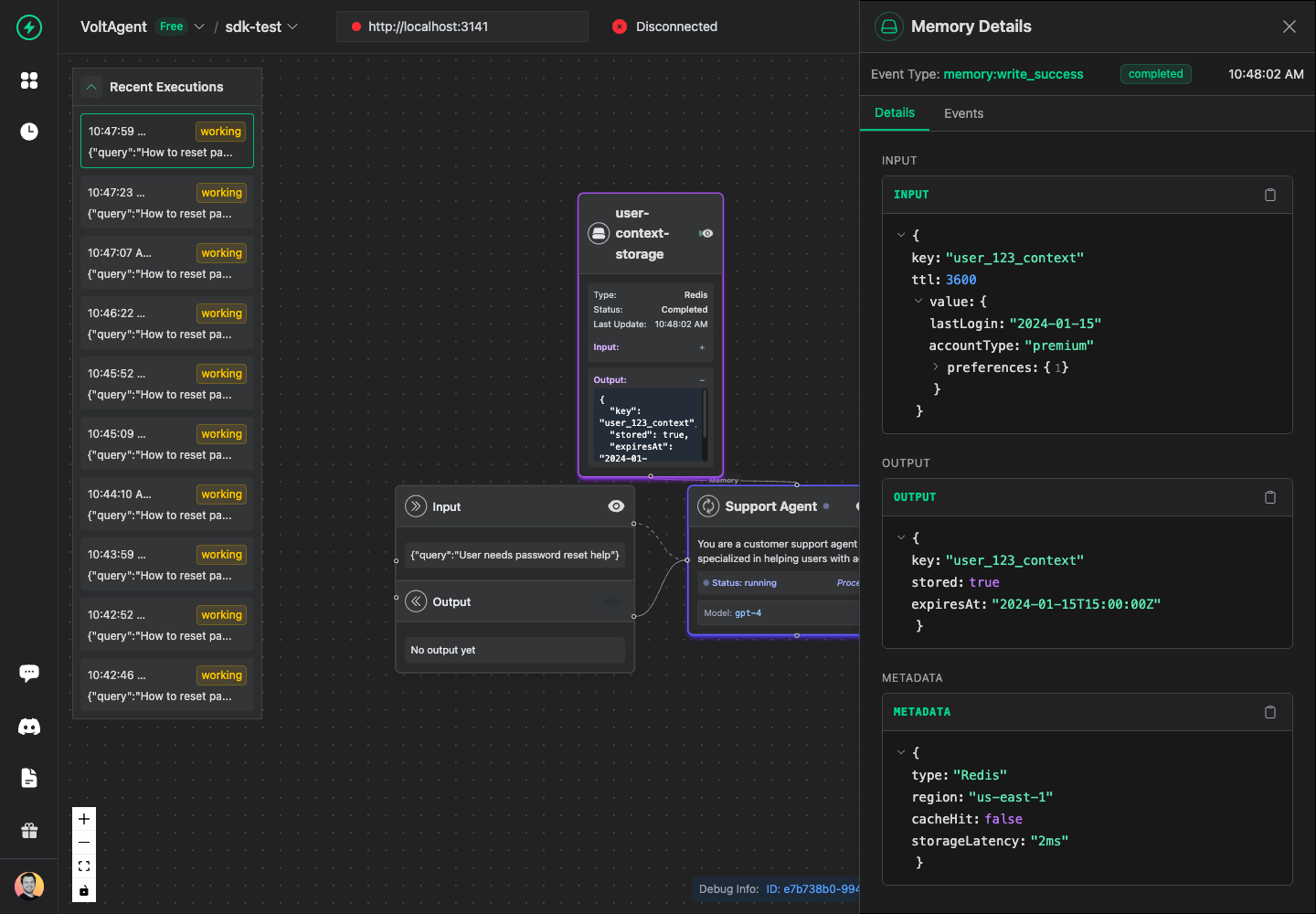
Memory Error
await memory_op.error(
status_message=Exception("Redis connection failed"),
metadata={
"storage_type": "redis",
"error_code": "CONNECTION_TIMEOUT",
},
)
Add Retrieval Operations
Retrievers handle data retrieval from vector stores, databases, or knowledge bases. They also follow the same success/error pattern:
retriever = await agent.add_retriever({
"name": "policy-document-retriever",
"input": {
"query": "password reset policy for premium users",
"max_documents": 3,
"threshold": 0.8,
},
"metadata": {
"vector_store": "pinecone",
"embedding_model": "text-embedding-ada-002",
},
})
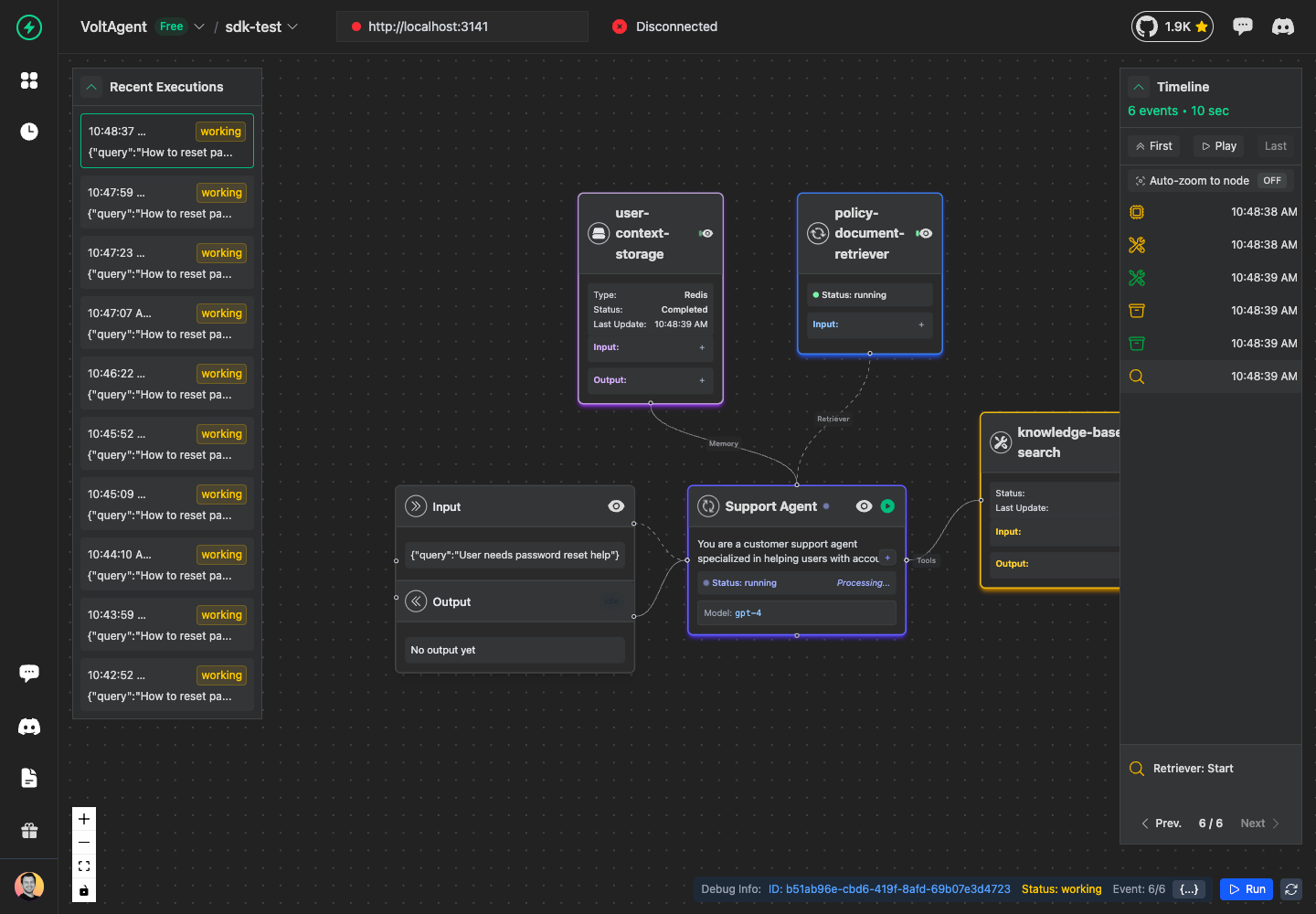
Retriever Success
await retriever.success(
output={
"documents": [
"Premium users can reset passwords instantly via email",
"Password reset requires 2FA verification for premium accounts",
"Premium users have 24/7 phone support for password issues",
],
"relevance_scores": [0.95, 0.88, 0.82],
},
metadata={
"search_time": "0.3s",
"documents_scanned": 1500,
},
)
Retriever Error
await retriever.error(
status_message=Exception("Vector store unavailable"),
metadata={
"vector_store": "pinecone",
"error_type": "SERVICE_UNAVAILABLE",
},
)
Working with Sub-Agents
Sub-agents create hierarchical agent structures. Each sub-agent can have its own tools, memory operations, and even more sub-agents:
# Create a sub-agent under the main agent
policy_checker = await agent.add_agent({
"name": "Policy Checker",
"input": {
"user_id": "user-123",
"request_type": "password-reset",
},
"instructions": "You are responsible for verifying customer requests against company policies.",
"metadata": {
"role": "policy-verification",
"modelParameters": {
"model": "gpt-4",
},
},
})

Sub-Agent Success
from voltagent import TokenUsage
await policy_checker.success(
output={
"policy_compliant": True,
"required_verification": "2fa-sms",
"approval_granted": True,
},
usage=TokenUsage(
prompt_tokens=85,
completion_tokens=45,
total_tokens=130,
),
metadata={
"policies_checked": ["password-policy", "premium-user-policy"],
"compliance_score": 0.95,
},
)

Sub-Agent Error
await policy_checker.error(
status_message=Exception("Policy verification failed"),
stage="policy_check",
metadata={
"failed_policies": ["premium-user-policy"],
"error_code": "POLICY_VIOLATION",
},
)
Creating Deeper Hierarchies
You can create multiple levels of sub-agents:
# Sub-sub-agent under policy checker
verifier = await policy_checker.add_agent({
"name": "2FA Verifier",
"input": {"user_id": "user-123"},
"instructions": "You handle two-factor authentication verification processes.",
"metadata": {
"role": "two-factor-auth",
"modelParameters": {
"model": "gpt-3.5-turbo",
},
},
})

Complete the Agent and Trace
Finally, complete your main agent and trace:
- Context Manager
- Manual
# Complete the main agent
await agent.success(
output={
"response": "Password reset link sent to user's email",
"action_taken": "email-reset-link",
"user_satisfied": True,
},
usage=TokenUsage(
prompt_tokens=150,
completion_tokens=85,
total_tokens=235,
),
metadata={
"response_time": "2.1s",
"confidence_score": 0.95,
},
)
# Trace automatically completes when exiting context manager
# Complete the main agent
await agent.success(
output={
"response": "Password reset link sent to user's email",
"action_taken": "email-reset-link",
"user_satisfied": True,
},
usage=TokenUsage(
prompt_tokens=150,
completion_tokens=85,
total_tokens=235,
),
metadata={
"response_time": "2.1s",
"confidence_score": 0.95,
},
)
# Manually complete the trace
await trace.end(
status=TraceStatus.COMPLETED,
output={
"result": "Customer support query resolved successfully",
"resolution": "password-reset-completed",
},
usage=TokenUsage(
prompt_tokens=150,
completion_tokens=85,
total_tokens=235,
),
metadata={
"total_agents": 2,
"total_operations": 4,
"success_rate": 1.0,
},
)

Best Practices
- Use context managers when possible - They provide automatic resource cleanup
- Always call
await sdk.flush()before your application exits - Use meaningful names for traces, agents, tools, and operations
- Include relevant metadata for debugging and analytics
- Track token usage in the
usagefield, not metadata - Handle errors properly with descriptive error messages
- Use hierarchical agents for complex workflows
- Set appropriate tags for easy filtering and search
- Use type hints for better code maintainability
- Handle asyncio properly in your application lifecycle
Complete Examples
- Context Manager Example
- Manual Management Example
import asyncio
import os
from voltagent import VoltAgentSDK, TokenUsage
async def context_manager_example():
sdk = VoltAgentSDK(
base_url=os.getenv("VOLTAGENT_BASE_URL", "https://api.voltagent.dev"),
public_key=os.getenv("VOLTAGENT_PUBLIC_KEY"),
secret_key=os.getenv("VOLTAGENT_SECRET_KEY"),
auto_flush=True,
)
try:
# Context manager automatically handles trace lifecycle
async with sdk.trace(
agentId="example-agent",
input={"query": "Show me how to use the SDK"},
) as trace:
# Add agent
agent = await trace.add_agent({
"name": "Example Agent",
"input": {"task": "Demonstrate SDK usage"},
"instructions": "You demonstrate how to use the VoltAgent SDK effectively.",
"metadata": {
"modelParameters": {"model": "gpt-4"},
},
})
# Add tool
tool = await agent.add_tool({
"name": "example-tool",
"input": {"action": "demonstrate"},
})
await tool.success(
output={"result": "Tool executed successfully"},
)
# Complete agent
await agent.success(
output={"response": "SDK demonstration completed"},
usage=TokenUsage(prompt_tokens=50, completion_tokens=30, total_tokens=80),
)
# Trace automatically completes here
except Exception as error:
print(f"Example failed: {error}")
finally:
await sdk.shutdown()
if __name__ == "__main__":
asyncio.run(context_manager_example())
import asyncio
import os
from voltagent import VoltAgentSDK, TokenUsage, TraceStatus
async def manual_example():
sdk = VoltAgentSDK(
base_url=os.getenv("VOLTAGENT_BASE_URL", "https://api.voltagent.dev"),
public_key=os.getenv("VOLTAGENT_PUBLIC_KEY"),
secret_key=os.getenv("VOLTAGENT_SECRET_KEY"),
auto_flush=True,
)
# Create trace manually
trace = await sdk.create_trace(
agentId="example-agent",
input={"query": "Show me how to use the SDK"},
)
try:
# Add agent
agent = await trace.add_agent({
"name": "Example Agent",
"input": {"task": "Demonstrate SDK usage"},
"instructions": "You demonstrate how to use the VoltAgent SDK effectively.",
"metadata": {
"modelParameters": {"model": "gpt-4"},
},
})
# Add tool
tool = await agent.add_tool({
"name": "example-tool",
"input": {"action": "demonstrate"},
})
await tool.success(
output={"result": "Tool executed successfully"},
)
# Complete agent
await agent.success(
output={"response": "SDK demonstration completed"},
usage=TokenUsage(prompt_tokens=50, completion_tokens=30, total_tokens=80),
)
# Manually complete trace
await trace.end(
status=TraceStatus.COMPLETED,
output={"result": "Example completed successfully"},
usage=TokenUsage(prompt_tokens=50, completion_tokens=30, total_tokens=80),
)
except Exception as error:
print(f"Example failed: {error}")
# Manually handle error
await trace.end(
status=TraceStatus.ERROR,
metadata={"error": str(error)},
)
finally:
await sdk.shutdown()
if __name__ == "__main__":
asyncio.run(manual_example())
Environment Variables
For easier configuration, set these environment variables:
export VOLTAGENT_BASE_URL="https://api.voltagent.dev"
export VOLTAGENT_PUBLIC_KEY="your-public-key"
export VOLTAGENT_SECRET_KEY="your-secret-key"
Then initialize the SDK simply:
sdk = VoltAgentSDK(
base_url=os.getenv("VOLTAGENT_BASE_URL"),
public_key=os.getenv("VOLTAGENT_PUBLIC_KEY"),
secret_key=os.getenv("VOLTAGENT_SECRET_KEY"),
auto_flush=True,
)
Type Safety
The Python SDK provides comprehensive type hints for better development experience:
from typing import Dict, Any, List, Optional
from voltagent import VoltAgentSDK, TokenUsage, TraceStatus
# SDK methods are fully typed
sdk: VoltAgentSDK = VoltAgentSDK(...)
# All data structures support type hints
metadata: Dict[str, Any] = {
# Built-in SDK field for model configuration
"modelParameters": {
"model": "gpt-4",
"temperature": 0.7,
},
# Custom user-defined fields (examples)
"user_session_id": "session_123",
"priority": "high",
"environment": "production",
}
usage: TokenUsage = TokenUsage(
prompt_tokens=100,
completion_tokens=50,
total_tokens=150,
)